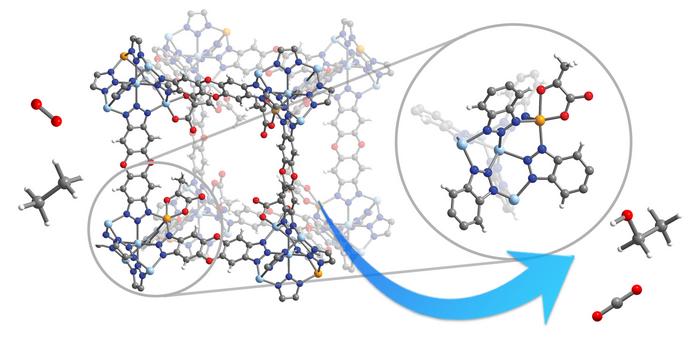Burning of natural gas at oil and gas wells, called flaring, is a major waste of fossil fuels and a contributor to climate change. But to date, capturing the flared natural gas, estimated at some 140 billion cubic meters per year by the International Energy Agency, has not been economically feasible.

Credit: Jonas Börgel/UC Berkeley
Burning of natural gas at oil and gas wells, called flaring, is a major waste of fossil fuels and a contributor to climate change. But to date, capturing the flared natural gas, estimated at some 140 billion cubic meters per year by the International Energy Agency, has not been economically feasible.
University of California, Berkeley, chemists have now come up with a simple and green way to convert these gases — primarily methane and ethane — into economically valuable liquids, mostly alcohols like methanol and ethanol. The liquids are also easier to store.
The alcohols can be used as feedstocks for production of numerous other petrochemical products, providing an additional revenue source for oil and gas companies but also lowering carbon dioxide emissions from flaring. Flaring is used to mitigate the more harmful effects of directly venting natural gas — methane is 34 times more potent as a greenhouse gas than carbon dioxide — into the atmosphere.
Details of the process were published Nov. 3 in the journal Science.
The new process for oxygenating hydrocarbons to alcohols mimics the way plants and animals add oxygen to carbon-hydrogen bonds to produce energy from carbohydrates, fats and proteins. Carbon-hydrogen bonds are equally abundant in the hydrocarbon molecules that comprise fossil fuels.
The natural oxidation processes involve an enzyme centered around a reactive metal — in most cases, iron — that catalyzes the insertion of an oxygen atom between a carbon and hydrogen bond to produce C-O-H, an alcohol group.
Much research has gone into finding variants of these natural enzymes that would convert gaseous hydrocarbons from fossil fuels into liquid alcohols without the energy input and huge infrastructure needed today in the chemical industry. But most of these processes involve artificial enzymes in a liquid solution.
The UC Berkeley innovation incorporates these reactive iron sites into a rigid and porous crystalline structure — a metal-organic framework, or MOF — that stabilizes the iron and allows easy entry of gas and easy exit of liquid alcohols.
“We have a lot of natural gas wells here that are too small for building a large-scale facility around it to convert ethane to ethanol or methane to methanol,” said Jonas Börgel, a UC Berkeley postdoctoral fellow who is first author of the paper, along with former graduate student Kaipeng Hou, now a postdoctoral fellow at UCSF. Both worked in the lab of Jeffrey Long, a UC Berkeley professor of chemistry and of chemical and biomolecular engineering and a faculty scientist at Lawrence Berkeley National Laboratory (Berkeley Lab).
“This system is nice, in that it is the first purely synthetic and not enzymatic process that can utilize oxygen at near ambient temperature to perform these reactions reminiscent of metalloenzyme reactivity,” Börgel said. “That’s where it really shows its potential for converting natural gas components into more easily storable energy sources like alcohols. The big advantage of this is converting natural gas into something that has more value than the gas itself and which has the potential to actually be more economically feasible.”
While the process is still being perfected, Börgel said that if it proves efficient at producing alcohols with less energy input than current processes, it might also be useful in large-scale facilities, many of which produce megatons of alcohols per year from natural gas.
“The standard way to oxygenate hydrocarbons is a multi-step process that involves high temperature and heterogeneous catalysts that only function at those temperatures, and that’s very energy intensive,” he said, “whereas this process has the potential to work at temperatures much closer to ambient temperatures — 25 to 50 degrees Celsius.”
Hou and Börgel first noted that an iron-containing variant of the MOF called MFU-4l — made primarily from zinc chloride and organic bis-triazole ligands — could be chemically modified to yield an active iron (II) site that resembles the active site in a natural enzyme called taurine dioxygenase (TauD), which oxygenates the amino acid taurine.
“We were inspired by the enzyme active site in TauD — the geometry around the iron center looks very similar to the coordination geometry around the peripheral metals in the nodes in this metal organic framework,” he said. “We thought that if we modified the MOF in the same way and put another ligand on there that is like the cofactor in the enzyme, maybe we would be able to mimic the C-H oxygenation reactivity that the enzyme has. That turned out to be true.”
“This is a great example of how the protected confines within the pores of a MOF can be used to create the types of highly reactive metal sites found in enzymes,” Long said.
The researchers conducted a detailed spectroscopic analysis of the modified MOF and confirmed that the iron(II) active site was acting just like the iron(II) site in TauD, converting hydrocarbons to alcohols.
“We’re now trying to move from our Science paper, which was about a lot of fundamental chemistry, to working on making this a more amenable process,” Börgel said.
The research was supported by the U.S. Department of Energy Office of Basic Energy Sciences (DE-SC0019992). Some of the spectroscopic measurements were conducted at Berkeley Lab’s Advanced Light Source.
The UC Berkeley team collaborated with colleagues from Max Planck Institutes in Germany, Argonne National Laboratory and Northwestern University in Illinois, the University of Milan in Italy, the University of Missouri in Rolla, Berkeley Lab and UC Davis.
Journal
Science
DOI
10.1126/science.add7417
Method of Research
Experimental study
Article Title
Reactive high-spin iron(IV)-oxo sites through dioxygen activation in a metal-organic framework
Article Publication Date
2-Nov-2023




